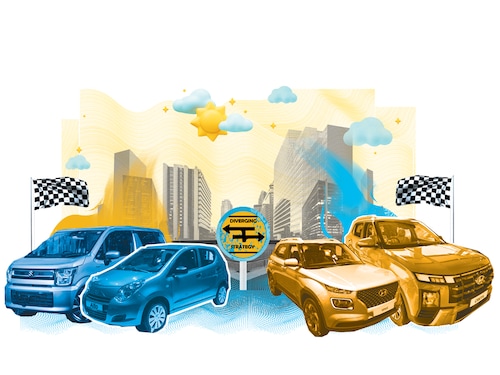Maruti, Hyundai: Same destination, different routes
Both car companies are chasing lost market share but while one is taking the small car route, the other is going the big car way


Two major carmakers in India are accelerating toward the same destination—market share recovery—but are taking sharply different routes to get there. While Maruti Suzuki is steering towards entry-level cars, Hyundai Motor India is doubling down on sport utility vehicles (SUVs).
Maruti’s market share has fallen from 51.3 percent in FY20 to 40.9 percent in FY25. The country’s largest carmaker wants to get back to 50 percent market share by FY31 for which it has planned Rs 70,000 crore in capex and cut car prices drastically.
Its hatchbacks Alto and S-Presso are roughly 25-30 percent cheaper after the Goods and Services Tax (GST) cut in September and are now back near the 2019-2020 price territory.
“Festive demand was driven by small cars, not SUVs,” Chairman R C Bhargava said during a post-earnings media call this month. “India is inherently a small-car market.”
He argued that the recent decline in hatchback sales was because of lack of affordability and not because Indians’ aspirations had changed.
“Many could not afford to buy the more expensive small cars earlier, and now that prices have come down, they have returned to the market.” Eighty-five percent of Indian households still earn far below Rs 15 lakh a year.
GST on small cars was reduced to 18 percent, from 28 percent earlier, with effect from September 22. The demand surge was immediate.
Partho Banerjee, senior executive officer, marketing & sales, said in a statement: “Since the day we announced reduced prices, we have received 4.5 lakh bookings [till Dhanteras] and of this 1 lakh is for small cars.” Bookings of entry-level cars grew 70 percent and their contribution to total sales has risen from 16.7 percent pre-GST to 22 percent post-GST 2.0.
Retail behaviour is outrunning production. Dispatches of mini cars (Alto + S-Presso) fell 15 percent to 9,067 in October. But a spokesperson said retail sales exceeded 15,000 while bookings crossed 25,800 during the month.
The carmaker said it is seeing 2-wheeler customers coming back and upgrading to entry-level cars after the price cuts.
Bhargava said Maruti will be flexible to the demand scenario and may have to make changes to production lines. The carmaker will look at upgrading models and adding new ones.
“Some other OEMs may also realise this and revise their product mix,” he said.
Also Read: EVs The Biggest Growth Driver in The Near Term: Incoming Hyundai India CEO
Saharsh Damani, CEO of Federation of Automobile Dealers Associations (FADA), said it was unprecedented to see prices being rolled back like this. “There are a few products in the Maruti stable which are at 2019-2020 prices. This has never been seen before.”
S-Presso, which is now India’s cheapest car, is approximately 30 percent cheaper, with its starting price of Rs 3.5 lakh.
Damani said a buyer who was earlier spending Rs 1.5-2 lakh on an electric two-wheeler can “add a lakh more and get a four-wheeler. We have never seen this kind of deal before”.
Hyundai—which was once India’s No. 2 carmaker and is now at No. 4—has seen its market share slip from 17.5 percent in FY20 to 14 percent previous fiscal, its lowest in over a decade. To reverse the slide, it has launched a capex plan of Rs 45,000 crore over five years which includes 26 new vehicles and a target to get back to 15 percent by FY30.
Hyundai believes the mass buyer has jumped aspirational altitude permanently.
“SUVs are the toast of the nation even after the GST rate cuts, they are driving the growth of the domestic market,” Tarun Garg, COO, Hyundai Motor India, said during a media interaction at the launch of the new Venue. “Customers have shifted their entry point. They are looking to upgrade to bigger cars rather than buy smaller ones.”
SUVs already make up 71 percent of Hyundai’s domestic sales. Garg believes this can “touch 80 percent by 2030".
While hatchback share in overall PV dispatches for industry has slipped from 22.4 percent in January-August this year to 20 percent in October, Hyundai reads that not as a production constraint but a lasting transition.
Another area where the two carmakers differ is on margins.
While Bhargava said Maruti will continue to bet on small cars even if margins aren’t high there, Garg said margins are as important for Hyundai as volumes. Hyundai, he said, doesn’t plan to get into a price war and will look for sustainable growth. “We always believe in quality of sales and quality of growth, because that is sustainable.”
In the small car vs SUV debate, the two carmakers are, in effect, placing opposing bets on the Indian middle class. In the coming years, the country will decide which bet was closer to reality, and which company simply took the wrong turn.
First Published: Nov 07, 2025, 11:52
Subscribe Now